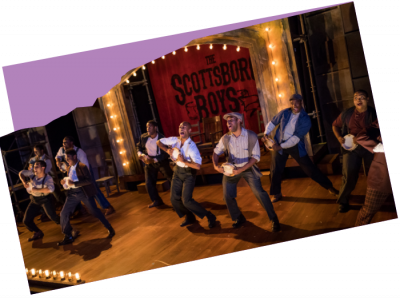Your donation sets the stage for a new season of Boston's most intimate, entertaining and provocative plays and musicals. Our shows make powerful connections with our audiences-- and they are only possible because of you.
Calendar
Search
Scottsboro Boys Timeline
Scottsboro Boys Timeline
The story of the Scottsboro Boys does not fit an easy narrative arc: it is a decade-spanning struggle involving more than a dozen key players and a seemingly endless parade of trials, verdicts, appeals and Supreme Court rulings. Even when the nine men at the center of the story were released from prison, none of them were left truly “free,” as their experiences haunted them for the rest of their lives. The timeline below highlights a few of the many twists and turns the story took as the nation looked on.
MAR 25, 1931
SCOTTSBORO BOYS ARRESTED
Nine black teenagers are arrested after a fight with a group of white teenagers on a train to Memphis. The black boys are accused of rape by Ruby Bates and Victoria Price, two white women also pulled from the train.
SCOTTSBORO BOYS ARRESTED
Nine black teenagers are arrested after a fight with a group of white teenagers on a train to Memphis. The black boys are accused of rape by Ruby Bates and Victoria Price, two white women also pulled from the train.
APR, 1931
FIRST TRIALS
With a lynch mob outside the jail, an all-white jury is assembled for the trials. Though all jurors believe the Boys to be guilty, the trials result in a hung jury. Judge Hawkins declares a mistrial and sentences eight of the Boys to death by electric chair.
FIRST TRIALS
With a lynch mob outside the jail, an all-white jury is assembled for the trials. Though all jurors believe the Boys to be guilty, the trials result in a hung jury. Judge Hawkins declares a mistrial and sentences eight of the Boys to death by electric chair.
JAN – MAR, 1932
FIRST APPEALS
Despite an admission from Ruby Bates that she lied about being raped, the Alabama Supreme Court upholds seven of the eight convictions.
FIRST APPEALS
Despite an admission from Ruby Bates that she lied about being raped, the Alabama Supreme Court upholds seven of the eight convictions.
NOV, 1932
US SUPREME COURT
The US Supreme Court reverses the convictions of the Scottsboro Boys,
citing the Alabama Court’s failure to provide them with adequate legal counsel.
US SUPREME COURT
The US Supreme Court reverses the convictions of the Scottsboro Boys,
citing the Alabama Court’s failure to provide them with adequate legal counsel.
JAN – APR, 1933
SECOND TRIAL
Samuel Liebowitz is retained by International Labor Defense (IDL) to serve as attorney for the Boys’ appeals. Haywood Patterson is found guilty a second time.
SECOND TRIAL
Samuel Liebowitz is retained by International Labor Defense (IDL) to serve as attorney for the Boys’ appeals. Haywood Patterson is found guilty a second time.
APR – MAY, 1933
PUBLIC OUTCRY
Seven of the trials are postponed due to public hostility towards the accused. Thousands of activists march on Washington, DC to protest the trials in support of the defendants.
PUBLIC OUTCRY
Seven of the trials are postponed due to public hostility towards the accused. Thousands of activists march on Washington, DC to protest the trials in support of the defendants.
DEC, 1933 – APR, 1935
PATTERSON AND NORRIS
Haywood Patterson and Clarence Norris are tried again, and again both sentenced to death. Their convictions are overturned by the US Supreme Court because African Americans were excluded from jury selection.
PATTERSON AND NORRIS
Haywood Patterson and Clarence Norris are tried again, and again both sentenced to death. Their convictions are overturned by the US Supreme Court because African Americans were excluded from jury selection.
JAN 23, 1936
PATTERSON SENTENCED
Haywood Patterson is convicted a fourth time and sentenced to 75 years in prison, marking the first time a black man convicted in the US of raping a white woman was not sentenced to death.
PATTERSON SENTENCED
Haywood Patterson is convicted a fourth time and sentenced to 75 years in prison, marking the first time a black man convicted in the US of raping a white woman was not sentenced to death.
JAN 24, 1936
OZIE POWELL
Ozie Powell attacks two police officers with a pocket knife after being threatened; one of the officers shoots Powell in the head. Both men survive, but Powell suffers permanent brain damage.
OZIE POWELL
Ozie Powell attacks two police officers with a pocket knife after being threatened; one of the officers shoots Powell in the head. Both men survive, but Powell suffers permanent brain damage.
1937
RUBY BATES
Ruby Bates tours with the International Labor Defense, apologizing for her role in the Boys’ convictions and advocating for their freedom.
RUBY BATES
Ruby Bates tours with the International Labor Defense, apologizing for her role in the Boys’ convictions and advocating for their freedom.
JULY, 1937
FINAL CONVICTIONS
Charlie Weems is convicted and sentenced to 105 years in prison. Clarence Norris is convicted and sentenced to death once again, but his sentence is reduced to life in prison.
FINAL CONVICTIONS
Charlie Weems is convicted and sentenced to 105 years in prison. Clarence Norris is convicted and sentenced to death once again, but his sentence is reduced to life in prison.
JULY, 1937
CHARGES DROPPED
Rape charges against Ozie Powell are dropped as part of a plea bargain, and he is sentenced to 20 years for assaulting the deputy who shot him. After four years in prison, all charges are dropped against Olen Montgomery, Willie Roberson, Roy Wright, and Eugene Williams.
CHARGES DROPPED
Rape charges against Ozie Powell are dropped as part of a plea bargain, and he is sentenced to 20 years for assaulting the deputy who shot him. After four years in prison, all charges are dropped against Olen Montgomery, Willie Roberson, Roy Wright, and Eugene Williams.
1940 – 1944
AFTERMATH
Charlie Weems, Clarence Norris, and Andy Wright are paroled; Norris and Wright later return to prison after violating their parole.
AFTERMATH
Charlie Weems, Clarence Norris, and Andy Wright are paroled; Norris and Wright later return to prison after violating their parole.
1947 – 1952
HAYWOOD PATTERSON
Haywood Patterson escapes from prison. He publishes his book The Scottsboro Boy. He is arrested by the FBI for escaping prison, but Michigan’s governor denies extradition. Patterson is convicted of manslaughter after his involvement in the death of another man in a barfight. He dies of cancer in prison.
HAYWOOD PATTERSON
Haywood Patterson escapes from prison. He publishes his book The Scottsboro Boy. He is arrested by the FBI for escaping prison, but Michigan’s governor denies extradition. Patterson is convicted of manslaughter after his involvement in the death of another man in a barfight. He dies of cancer in prison.
APR 19, 2013
EXONERATION
More than 82 years after they were wrongfully accused, the Scottsboro Boys are officially granted a pardon by the Governor of Alabama.
EXONERATION
More than 82 years after they were wrongfully accused, the Scottsboro Boys are officially granted a pardon by the Governor of Alabama.
Because of You
SpeakEasy Signups
Sign up to get the latest updates on all our shows, readings, workshops and programs.
 Past Productions
Past Productions Primary Trust
Primary Trust Lizard Boy: A NEW MUSICAL
Lizard Boy: A NEW MUSICAL JOB
JOB The Antiquities
The Antiquities Swept Away
Swept Away




